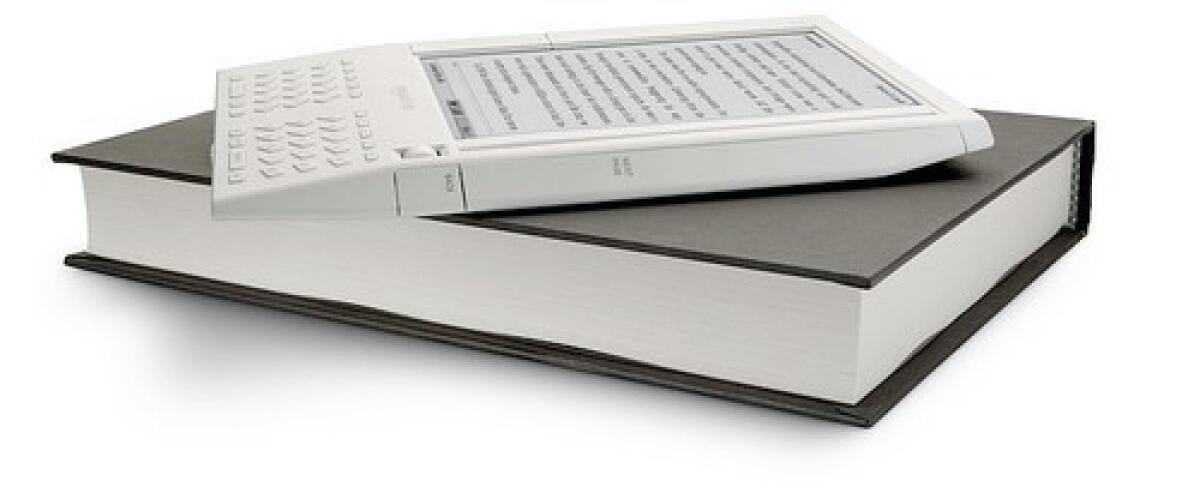A must-read for book lovers?

- Share via
November 28, 2007
For more than a decade, inventors have tried to come up with a high-tech version of that most sacred of analog content delivery systems: the book.
The results have been gizmos only an uber-geek could love.
But finally, someone has come up with a version for humans. At least some humans.
Amazon.com last week unveiled the Kindle, a hand-held, rechargeable device that can store hundreds of books, newspapers and magazines to be accessed and read page by page on the go. You can even use it in the living room, curled up in your favorite reading chair.
The experience of looking at a page on the Kindle screen is more like seeing one in an actual book than gazing into the glare of a computer or cellphone display.
The device is slim, only slightly larger than a mass-market paperback, and can do things no book can do, including look up the definition of a word with a click of a couple of buttons.
Furthermore, Kindle doesn’t require a computer to download a book. It works off a cellular phone network that covers most of the country.
The price tag -- $399, not counting books or other downloads -- is considerable enough to put it in early-adopter territory in its first go-round.
It’s not perfect by any means. And there is a visceral pleasure to holding a real book -- and surveying a real bookshelf -- that no digital device can duplicate. At least not yet.
But after many misfires over the years, Kindle might be able to convince even a hardened book lover that there could be a place for a digital device in the world of serious reading. Or just for perusing the latest trashy novel.
Kindle (the name is a reference to the word “inspire,” according to the packaging, but there’s an unfortunate association with book burning) sports a 3½-inch-by-4¾-inch screen and a miniature keyboard.
Up front are “Next Page” and other navigation keys that take a bit of getting used to (the first few hours with Kindle were maddening).
Battery life is decent. In a test during which the Kindle was used almost constantly, it lasted 6½ hours before a low-power warning appeared. Turning off the wireless component with a flick of a switch on the back of the unit stretched the battery life at least a couple more hours.
In other words, a full charge would more than last through a cross-country flight. Speaking of which, the fact that the wireless feature can be shut off makes Kindle legal for air travel.
The eminently readable screen is the main technological attraction. Using science developed by E Ink Corp. of Cambridge, Mass., it uses actual black ink that forms letters on the screen and then refreshes when the next page pops up.
The screen can reproduce black-and-white graphics fairly well and does a fuzzy job on photographs.
There’s no color -- a major drawback that pretty much eliminates art history and biology books.
On the upside, the screen doesn’t wash out in bright light. It’s not backlighted, however, so if you try to use it under the covers you’ll need a flashlight.
The screen is not original. There are other gadgets that use E Ink technology, including the Sony Reader, another hand-held book-reading device that debuted in 2005 and has hardly set the world on fire.
In fact, the primary innovation of Kindle is not technological. It’s in its use of e-commerce.
This is no surprise, given that Amazon revolutionized that field with its launch in 1995. The site thrived, at least in part, because it was so tantalizingly easy to use. A couple of clicks and the money went from your bank account to theirs.
Kindle is infused with the same spirit. Because it works via Sprint Nextel Corp.’s cellular network, just about anywhere you can get a cellphone call, you can buy a book.
There were more than 92,000 titles available at the device’s launch, compared with 20,000 currently available for the Sony Reader. Subscriptions to 11 newspapers (not the Los Angeles Times) and eight magazines also are offered.
Kindle stores about 200 titles and Sony Reader holds about 180, based on an average-size book. Extra memory can be added to both.
Because Kindle is registered to the owner’s Amazon account, the credit card or bank account number used to make purchases is already on record.
Of course, no need to wait for real-world shipping. In tests of the device, most books arrived less than a minute after purchase.
This being an Amazon product, a sign appeared on the screen during that time inviting the consumer to “continue shopping” while waiting for the download to land.
Talk about nearly instant gratification. It’s like buying music online, only faster.
The convenience is apparent. You could board a flight carrying dozens of books in a device smaller than most hardbacks.
Kindle weighs about 10¼ ounces. Compare that with a current bestseller, the “Einstein” biography by Walter Isaacson, which has 675 pages and weighs in at nearly 2½ pounds.
It doesn’t take an Einstein to know which would be easier to carry around.
Generally, Kindle book versions are cheaper than the paper-and-ink originals. For example, the “Einstein” list price is $32, discounted to $19.20 on Amazon. The Kindle price is $9.99, which is the top charge for books on the service.
Monthly newspaper subscriptions go for $15 or less a month (they’re not updated during the day) and several magazines cost about $5 a month.
For those who like to browse first, free samples are offered for most books, usually consisting of the first chapters, and trial subscriptions are offered for the newspapers and magazines.
The virtual versions come with advantages beyond savings in weight and bulk, including the aforementioned ability to look up word definitions. Whole pages can be selected and downloaded to a computer, electronic notes can be put in the margins and a search function can quickly find a passage.
Pages can be bookmarked. Just as in real life, this is signified by “turning down” a corner of the on-screen page.
Seeing that little corner fold down always got a laugh when people tried out Kindle.
It’s a delightful, clever product in many ways. And it’s likely to impress your friends.
But is it worth $399?
If there are lessons to be learned from the digital era, the primary one is: Thou shalt not buy the first version of the product.
Prices will drop (sometimes embarrassingly fast, as with the iPhone) and features will be added (hopefully color). And it remains to be seen how durable and practical the product will be in the real world.
In the meantime, there’s a stopgap way to enjoy a book even as hefty as “Einstein” without straining. Wait for the paperback.
More to Read
Sign up for The Envelope
Get exclusive awards season news, in-depth interviews and columnist Glenn Whipp’s must-read analysis straight to your inbox.
You may occasionally receive promotional content from the Los Angeles Times.









